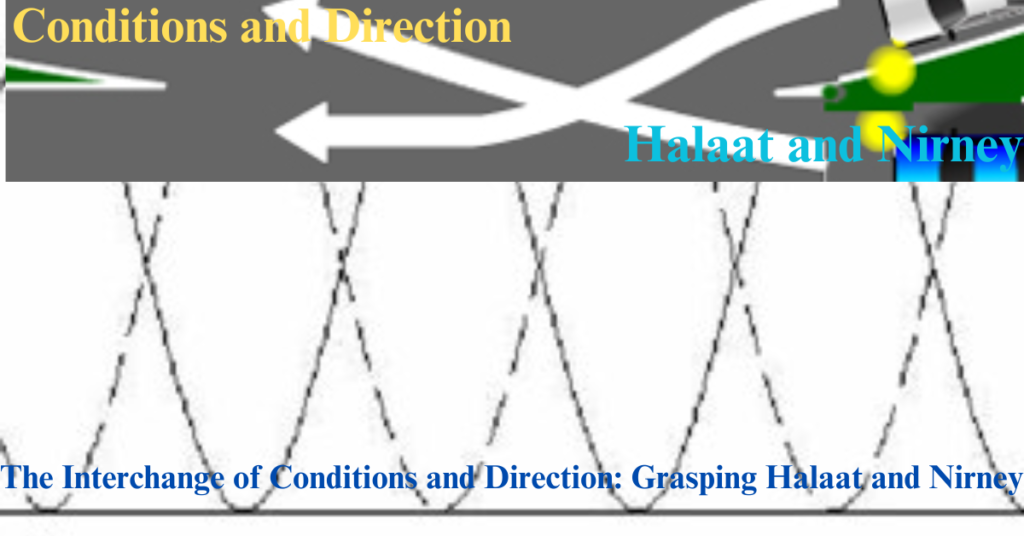
The Interchange of Conditions and Direction: Grasping Halaat and Nirney
Table of Contents
The Interchange of Conditions and Direction: Grasping Halaat and Nirney
Halaat and Nirney are the two complicated woven artwork of human life, two ideas frequently hang out in characterizing the course of our lives: halaat (conditions) and nirney (navigation). These terms, established in the rich semantic and social customs of South Asia, embody the crucial transaction between the circumstances we end up in and our decisions accordingly. Understanding how halaat and nirney impact each other can give deep experiences into human way of behaving, cultural patterns, and self-improvement.
Characterizing Halaat and Nirney
Halaat
Halaat alludes to the outer circumstances or conditions that encompass an individual or gathering at some random time. These can incorporate social, monetary, political, and ecological variables, among others. Halaat can be both quick and long haul, forming the setting where choices are made. They are much of the time outside of a singular’s reach, going about as the scenery against which life unfurls.
Nirney
Nirney, then again, is the most common way of deciding. It includes gauging choices, taking into account likely results, and at last picking a strategy. Nirney is an activity of organization and judgment, affected by a singular’s qualities, encounters, and comprehension of their conditions.
The Interaction Among Halaat and Nirney
Halaat Molding Nirney
Conditions assume a vital part in molding the choices in between the Halaat and Nirney individuals make. For example, in the midst of monetary difficulty, people could focus on monetary dependability over seeking after interests or dangerous endeavors. Political turmoil or social insecurity can prompt choices pointed toward guaranteeing wellbeing and security as opposed to self-awareness or investigation. Ecological circumstances, for example, cataclysmic events, force individuals to make quick, endurance arranged choices, frequently with durable effects.
Nirney Affecting Halaat
On the other hand, the choices we make can adjust our conditions, at times decisively. Deciding to seek after advanced education can open up new profession open doors and change a person’s monetary and economic wellbeing. Choices about where to take up residence, whom to connect with, and how to invest energy and assets can reshape the halaat in which future choices are made. In this way, while we might be affected by our conditions, we additionally have the ability to change them through our decisions.
Verifiable Points of view on Halaat and Nirney
Since the beginning of time, the transaction among halaat and nirney has been obvious in the existences of compelling figures and crucial occasions.
Verifiable Figures
Think about the existence of Mahatma Gandhi. Naturally introduced to a period of English pilgrim rule in India, his halaat were set apart by mistreatment and social shamefulness. In spite of these conditions, his nirney to seek after peaceful opposition and common defiance prompted huge political change, in India as well as around the world. His choices, affected by his conditions, thus changed the halaat of millions, showing the significant effect that singular decisions can have on the more extensive setting.
Vital Occasions
The Modern Insurgency gives one more illustration of this dynamic. The unforgiving working circumstances and monetary abberations of the time (halaat) provoked specialists to decide (nirney) that prompted the development of worker’s guilds and requests for freedoms and assurances. These choices brought about huge social and monetary changes, changing the halaat for people in the future.
Mental Bits of knowledge into Halaat and Nirney
Mental Inclinations
The area of brain science offers important experiences into how people see and answer their conditions. Mental predispositions, for example, the positive thinking inclination or tendency to look for predetermined feedback, can impact how we decipher halaat and decide. The hopefulness predisposition, for example, may lead people to misjudge dangers and misjudge positive results, influencing their dynamic cycles.
Dynamic Models
A few models of direction have been proposed to comprehend how individuals explore their conditions. The Reasonable Dynamic Model proposes that people methodicallly assess every accessible choice and pick the one that augments utility. Notwithstanding, genuine choices are much of the time more perplexing, affected by feelings, prevailing difficulties, and fragmented data. The Limited Sanity Model, proposed by Herbert Simon, recognizes these impediments, recommending that people frequently settle for agreeable as opposed to ideal choices because of imperatives in time, data, and mental limit.
Social and Social Components of Halaat and Nirney
Social Impacts
Culture assumes a huge part in forming both halaat and nirney. Social standards and values impact how people see their conditions and the decisions they consider adequate or alluring. In collectivist social orders, choices might be more affected by family and local area contemplations, while in nonconformist societies, individual independence and individual objectives might come first.
Social Designs
Social designs, like class, orientation, and race, additionally influence the interchange among halaat and nirney. Minimized bunches frequently face additional difficult conditions, which can restrict their dynamic choices. Notwithstanding, social developments and support endeavors driven by aggregate navigation can change these designs, further developing circumstances for people in the future.
The Job of Innovation in Halaat and Nirney
Innovative Headways
Mechanical progressions have essentially affected the two conditions and dynamic cycles. The web and advanced innovations have changed how individuals access data, convey, and simply decide. For example, admittance to online instruction has set out new open doors for people to further develop their monetary and social halaat. Virtual entertainment stages take into consideration fast dispersal of data and preparation of social developments, impacting both individual and aggregate nirney.
Moral Contemplations
Be that as it may, innovation likewise raises moral contemplations. Issues like information protection, algorithmic inclination, and advanced partition feature the intricacies of exploring current conditions and going with informed choices. As innovation keeps on advancing, understanding its suggestions for halaat and nirney turns out to be progressively significant.
Future Headings in Grasping Halaat and Nirney
Interdisciplinary Methodologies
Future exploration on halaat and nirney can profit from interdisciplinary methodologies that incorporate bits of knowledge from brain research, human science, financial matters, and innovation studies. Such methodologies can give a more exhaustive comprehension of how conditions and dynamic cycles communicate and impact one another.
Strategy Suggestions
Understanding the elements of halaat and nirney has significant strategy suggestions. Policymakers can plan mediations that address unfriendly conditions and enable people to pursue informed choices. For example, arrangements pointed toward lessening financial imbalance, further developing schooling, and guaranteeing admittance to medical services can make better circumstances for positive dynamic results.
Conclusion
The ideas of halaat and nirney offer a significant focal point through which to see the human experience. By looking at the transaction among conditions and navigation, we gain experiences into the powers that shape our lives and the manners by which we can impact our predetermination. Whether at the degree of people, networks, or social orders, understanding halaat and nirney can assist us with exploring the intricacies of existence with more noteworthy mindfulness and reason. As we push ahead, embracing this understanding can engage us to make an all the more, impartial, and satisfying world.


